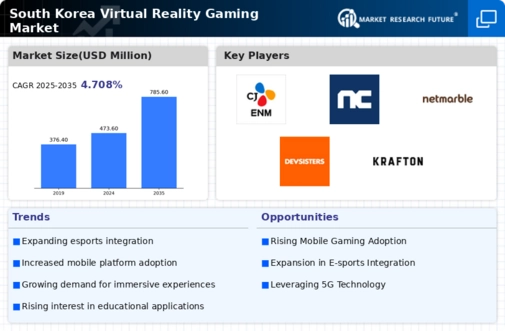Rising Demand for Immersive Experiences
The virtual reality-gaming market in South Korea is witnessing a notable increase in demand for immersive gaming experiences. As consumers seek more engaging and interactive forms of entertainment, the appeal of virtual reality (VR) gaming continues to grow. Recent data indicates that the market is projected to reach approximately $1.5 billion by 2026, reflecting a compound annual growth rate (CAGR) of around 25%. This surge is driven by advancements in VR technology, which enhance user experiences through improved graphics and interactivity. Furthermore, the proliferation of high-speed internet and affordable VR headsets has made these experiences more accessible to a broader audience. As a result, the virtual reality-gaming market is likely to expand significantly, catering to the evolving preferences of gamers who desire deeper immersion in their gaming activities.
Increased Investment in Game Development
Investment in game development is a crucial driver for the virtual reality-gaming market in South Korea. The country is home to numerous game development studios that are increasingly focusing on VR content creation. Recent reports indicate that the South Korean gaming industry is expected to reach $10 billion by 2025, with a significant portion of this growth stemming from VR gaming initiatives. This influx of capital allows developers to experiment with cutting-edge technologies and create high-quality VR games that appeal to diverse audiences. Moreover, partnerships between tech companies and game developers are becoming more common, fostering innovation and enhancing the overall quality of VR gaming experiences. As investment continues to flow into the virtual reality-gaming market, it is likely to stimulate further growth and attract new players to the industry.
Growing Popularity of Social VR Platforms
The rise of social VR platforms is emerging as a key driver for the virtual reality-gaming market in South Korea. These platforms enable users to interact with one another in virtual environments, fostering a sense of community and shared experiences. As social interactions become increasingly important in gaming, the demand for VR platforms that facilitate these connections is likely to grow. Recent surveys indicate that over 60% of gamers in South Korea express interest in social VR experiences, highlighting the potential for market expansion. This trend suggests that developers may prioritize creating multiplayer VR games that emphasize social engagement, thereby enhancing the appeal of the virtual reality-gaming market. As more players seek to connect with others in immersive settings, the growth of social VR platforms could significantly influence the trajectory of the market.
Expansion of Esports and Competitive Gaming
The virtual reality-gaming market in South Korea is significantly influenced by the rapid expansion of esports and competitive gaming. With a robust gaming culture, South Korea has become a hub for esports, attracting millions of viewers and participants. The integration of VR technology into competitive gaming is expected to enhance the spectator experience, offering new dimensions of engagement. Recent statistics suggest that the esports market in South Korea is valued at over $100 million, with a substantial portion of this growth attributed to VR gaming. This trend indicates a potential for increased investment in VR esports tournaments and events, further driving the popularity of the virtual reality-gaming market. As competitive gaming continues to evolve, the demand for innovative VR experiences is likely to rise, creating new opportunities for developers and gamers alike.
Advancements in Hardware and Software Technology
Technological advancements in hardware and software are pivotal to the evolution of the virtual reality-gaming market in South Korea. The continuous improvement of VR headsets, controllers, and software platforms enhances the overall gaming experience, making it more appealing to consumers. Recent developments in graphics processing units (GPUs) and motion tracking technology have led to more realistic and responsive VR environments. As a result, the market is expected to see a surge in demand for high-quality VR gaming experiences. Furthermore, the introduction of standalone VR headsets, which do not require external devices, is likely to broaden the consumer base. This trend indicates that as technology continues to advance, the virtual reality-gaming market will likely attract a wider audience, driving further growth and innovation in the industry.















Leave a Comment